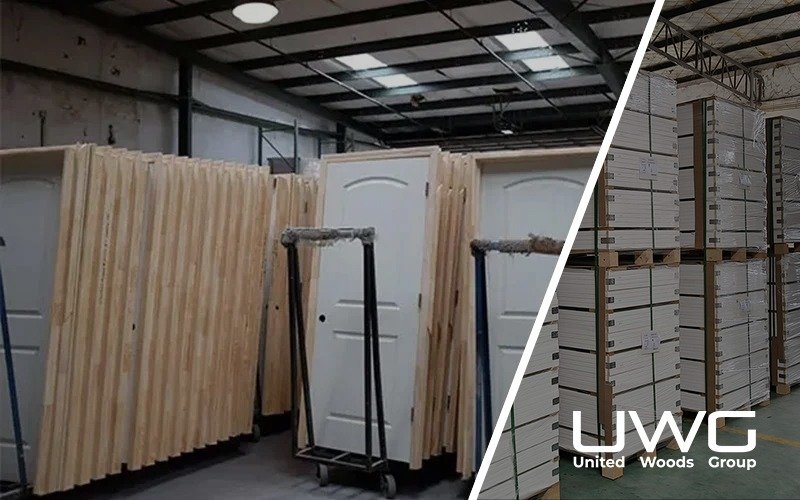When working on a door installation project, choosing the right type of door can be daunting. Many contractors and wholesalers face the dilemma of whether to opt for a prehung door or not. Understanding when a prehung door is necessary can save time, effort, and cost.
If you are working on a project where a door frame has not yet been built or an old, damaged door frame was removed, a prehung door is a convenient option that is relatively easy to install. Prehung doors come with the frame, hinges, and door already assembled, making them ideal for rough door openings and exterior doors.
Let’s delve deeper into the specifics of when a prehung door is the right choice.
What Are the Disadvantages of a Prehung Door?
Prehung doors can be more expensive than slab doors due to the additional materials and labor involved in manufacturing and shipping pre-assembled doors. They might not be suitable for all door openings, especially if the rough opening is not a standard size. Adjustments may be required to fit them properly.
Additionally, prehung doors are heavier and more cumbersome to transport and handle. This added weight can make the installation process more challenging, particularly in tight spaces or when working alone. The need for precise measurements and adjustments means that any mistake can lead to a poor fit, which might require additional time and resources to correct.
Despite these disadvantages, the convenience and ease of installation often outweigh the drawbacks, especially in new constructions or major renovations where speed and efficiency are crucial.

Can You Buy an Exterior Door That Is Not Prehung?
Yes, you can buy an exterior door that is not prehung. These are known as slab doors. With a slab door, you’ll need to purchase a metal strike plate, shims, mortises, hinges, and a doorknob separately.
Slab doors are lighter and generally cost less, making them a budget-friendly option.
However, installing a slab door requires more skill and precision. You need to ensure that the door fits perfectly within the existing frame, which can be a complex and time-consuming process.
This might involve cutting mortises for the hinges and ensuring the door is level and plumb. If the existing frame is in good condition and you have the necessary tools and expertise, a slab door can be a viable option.

Why Get a Prehung Door?
A prehung door can simplify installation. It typically comes predrilled for door hardware, and the frame is usually ready for the strike plate installation. You won’t need to position and install hinges, and the door will already be balanced and set to open and close properly, saving time and effort during installation.
Prehung doors are particularly beneficial in new construction projects where door frames are not yet in place. They ensure that the door and frame are perfectly aligned, which is crucial for the door’s proper functioning. This alignment helps prevent issues such as sticking or improper sealing, which can lead to drafts and energy loss in exterior doors.
For renovation projects, prehung doors are ideal when the existing door frame is damaged or outdated. Replacing both the door and frame simultaneously ensures a consistent and updated look, enhancing the overall aesthetics of the space.

How Do You Tell What Door You Need?
Start by measuring the width and height of the existing door slab. Round each number up to the nearest inch to determine the nominal door size you’ll need.
For single doors and doors with sidelites, measure only the door slab. For double doors, measure the width of the two door slabs together.
In addition to the door’s dimensions, consider the condition of the existing frame. If the frame is in good shape and only the door needs replacing, a slab door might be sufficient. However, if the frame is warped, damaged, or outdated, a prehung door could be the better option.
Another factor to consider is the door’s location. For exterior doors, prehung options are often preferred due to their better sealing capabilities and ease of installation.
For interior doors, the decision might depend more on the specific requirements of the project and the condition of the existing frame.

How to Know if I Need a Prehung Door?
If you’re unsure whether you need a prehung door, consider whether your door frame is already intact. If the frame is solid and doesn’t require replacement, a slab door might suffice. However, if the frame is missing or damaged, a prehung door is the better choice.
Evaluate the project’s scope and your skill level as well. Prehung doors are generally easier to install, making them a better choice for less experienced installers.
If time is a critical factor, the convenience of a prehung door can significantly speed up the installation process.
Consider the long-term benefits as well. A properly installed prehung door can provide better insulation and security, particularly for exterior doors.
The initial higher cost might be offset by the benefits of reduced energy loss and increased durability.

What Is a Pre-Hung Door vs Slab?
A prehung door includes the door slab, hinges, and frame, and it is pre-assembled for easy installation. A slab door, on the other hand, is just the door without the frame or hinges. Choosing between them depends on whether you need to replace the frame along with the door.
Prehung doors are often the go-to choice for new constructions and major renovations. They provide a complete, ready-to-install solution that ensures proper alignment and function. This makes them particularly useful in situations where the existing frame is either absent or beyond repair.
Slab doors, conversely, offer more flexibility in terms of customization and cost. They can be a better choice for projects where the existing frame is in good condition, and you have the skills and tools to handle the installation. They also allow for more design options, as you can pair them with different frame styles and finishes.

Prehung Interior Doors
Prehung doors are not only for exterior use; they can also be used for interior doors, especially in new constructions or major renovations where the frames are not yet installed. They ensure a uniform look and proper alignment throughout the house.
For interior doors, prehung options simplify the installation process, ensuring that the door operates smoothly and fits perfectly within the frame.
This is particularly important in high-traffic areas where doors are frequently used. Prehung doors can also help reduce sound transmission between rooms, enhancing privacy and comfort within the home.
In multi-door projects, using prehung doors can ensure consistency in the appearance and function of all doors. This uniformity can enhance the overall aesthetic of the interior, creating a cohesive and polished look.

How to Install a Prehung Door?
To install a prehung door, begin by placing the assembled door and frame into the rough opening. Ensure it is level and plumb before securing it with nails or screws.
Check the door for smooth operation and make any necessary adjustments to the hinges or frame.
Start by preparing the rough opening, ensuring it is the correct size and free of debris. Position the prehung door in the opening, using shims to adjust for any unevenness.
Secure the frame in place with nails or screws, checking frequently to ensure the door remains level and plumb.
Once the door is secured, test it to ensure it opens and closes smoothly. Make any necessary adjustments to the hinges or strike plate to ensure proper alignment.
Finally, install any additional hardware, such as the doorknob and lockset, following the manufacturer’s instructions.

Summary
Choosing the right type of door hinges on the condition of your door frame and the specific requirements of your project. Prehung doors offer convenience and ease of installation, making them a popular choice for both contractors and wholesalers. Whether for new construction or replacing damaged frames, understanding when to use a prehung door can streamline your project.
Selecting the appropriate door type can significantly impact the efficiency and outcome of your project. By considering the specific needs of your installation, you can make an informed decision that ensures a successful and satisfying result. Whether you choose a prehung door for its ease of installation or a slab door for its customization options, the key is to match the door type to the project’s requirements and your skill level.







